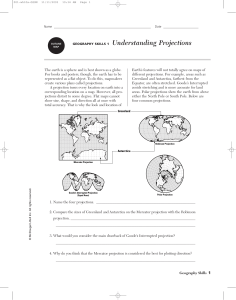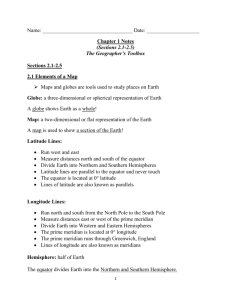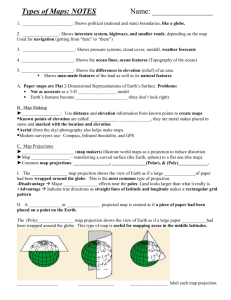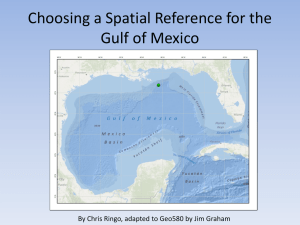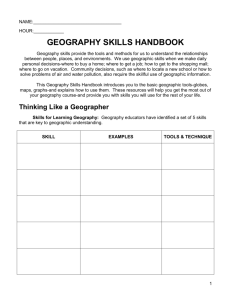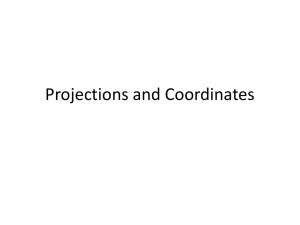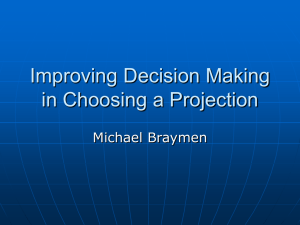Map Projections Lesson Plan: Advanced Geography
advertisement
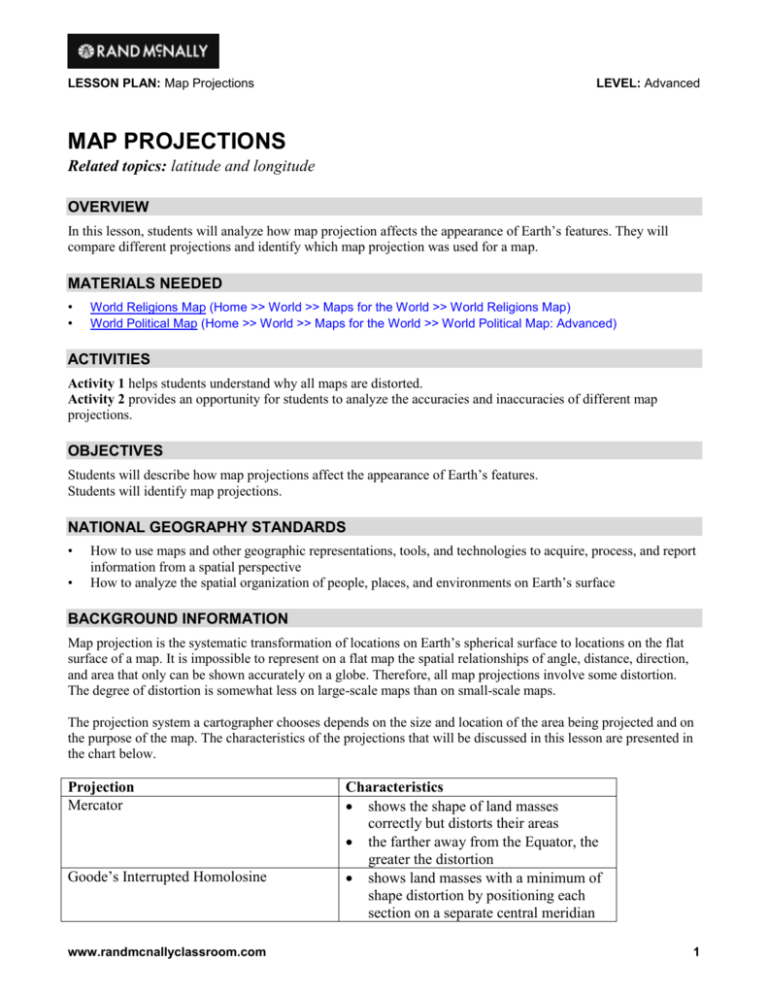
LESSON PLAN: Map Projections LEVEL: Advanced MAP PROJECTIONS Related topics: latitude and longitude OVERVIEW In this lesson, students will analyze how map projection affects the appearance of Earth’s features. They will compare different projections and identify which map projection was used for a map. MATERIALS NEEDED • • World Religions Map (Home >> World >> Maps for the World >> World Religions Map) World Political Map (Home >> World >> Maps for the World >> World Political Map: Advanced) ACTIVITIES Activity 1 helps students understand why all maps are distorted. Activity 2 provides an opportunity for students to analyze the accuracies and inaccuracies of different map projections. OBJECTIVES Students will describe how map projections affect the appearance of Earth’s features. Students will identify map projections. NATIONAL GEOGRAPHY STANDARDS • • How to use maps and other geographic representations, tools, and technologies to acquire, process, and report information from a spatial perspective How to analyze the spatial organization of people, places, and environments on Earth’s surface BACKGROUND INFORMATION Map projection is the systematic transformation of locations on Earth’s spherical surface to locations on the flat surface of a map. It is impossible to represent on a flat map the spatial relationships of angle, distance, direction, and area that only can be shown accurately on a globe. Therefore, all map projections involve some distortion. The degree of distortion is somewhat less on large-scale maps than on small-scale maps. The projection system a cartographer chooses depends on the size and location of the area being projected and on the purpose of the map. The characteristics of the projections that will be discussed in this lesson are presented in the chart below. Projection Mercator Goode’s Interrupted Homolosine www.randmcnallyclassroom.com Characteristics shows the shape of land masses correctly but distorts their areas the farther away from the Equator, the greater the distortion shows land masses with a minimum of shape distortion by positioning each section on a separate central meridian 1 LESSON PLAN: Map Projections LEVEL: Advanced Robinson shapes and sizes of land masses are represented accurately shows an uninterrupted view maintains overall shape and area relationships without extreme distortion ACTIVITY 1 Write the following statement on the board: All maps show a distorted view of Earth’s surface. Ask students to explain why the statement is true. [It is not possible to accurately represent the curved surface of Earth on the flat surface of a map.] If students have difficulty with this concept, you might have them do Activity 1 from Map Projections (Intermediate level). Explain that cartographers use different map projections to minimize the distortion of different areas on a map. Have students work individually or as a group to complete the worksheet titled “Analyzing Map Projections.” ACTIVITY 2 Have students examine a globe to determine the characteristics of lines of latitude and lines of longitude. Have them list the characteristics in a chart. Suggested responses: Meridians of Longitude All meridians of longitude are equal in length and meet at the Poles. Meridians of longitude are equally spaced on each parallel, but the distance between them decreases toward the Poles. Meridians cross parallels at right angles. Parallels of Latitude The circumference, or length, of parallels of latitude decreases from the Equator to the Poles. For example, the circumference of the parallel at 60º latitude is one-half the circumference of the Equator. All lines of latitude are parallel and equally spaced. Parallels cross meridians at right angles. Ask students to explain how the analysis of latitude and longitude helps explain the distortion shown on map projections. [Distortion is usually greater toward the poles because of the difficulty of showing the curved lines of longitude. A Mercator Projection shows lines of longitude parallel to one another.] CONCLUDING AND ASSESSMENT Display the World Religions Map and the World Political Map. Have students identify which map projection was used. [World Religions Map: Goode's Interrupted Homolosine Projection; World Political Map: Robinson Projection] Ask them to explain how they determined their answer. INTERNET CONNECTIONS Students can find directions for making a Mercator Projection at http://interactive2.usgs.gov/learningweb/teachers/exploremaps_lesson2_1.htm www.randmcnallyclassroom.com 2 LESSON PLAN: Map Projections LEVEL: Advanced CROSS-CURRICULAR CONNECTIONS Language Arts Ask students to imagine the following scenario: You are responsible for purchasing new maps for your school. What type of map projection would your maps have? Write the explanation you would use to convince the school board to provide the money for these maps. ANSWERS TO STUDENT WORKSHEET A. A Mercator Projection shows the shape of land masses accurately but distorts their sizes. B. A Goode’s Interrupted Homolosine Projection shows accurate sizes and shapes of land, but is interrupted in the ocean areas. C. A Robinson Projection shows accurate sizes, shapes, and relative positions of land with some distortion near the Poles. www.randmcnallyclassroom.com 3 Name: _______________________________________________________ Date: ___________________ ANALYZING MAP PROJECTIONS Identify the advantages and disadvantages of each projection below. A. Mercator Projection ___________________________________________________________________ ___________________________________________________________________ B. Goode’s Interrupted Homolosine Projection ________________________________________________________________________ ________________________________________________________________________ C. Robinson Projection _____________________________________________________________________ ________________________________________________________________________ 4
